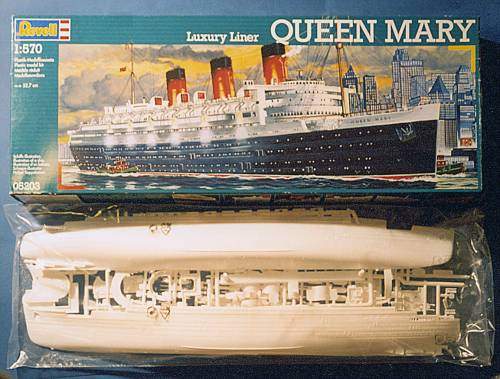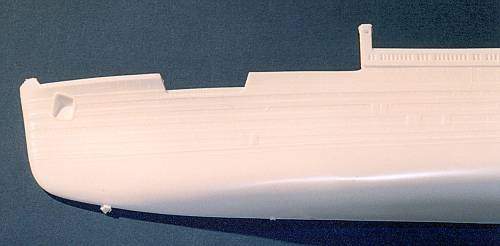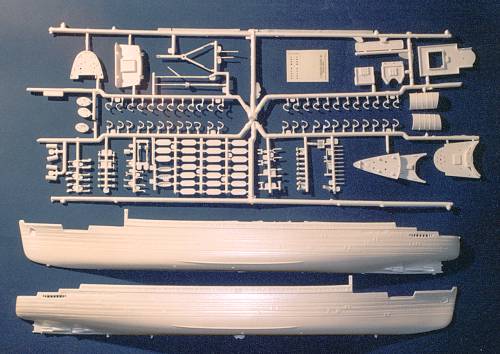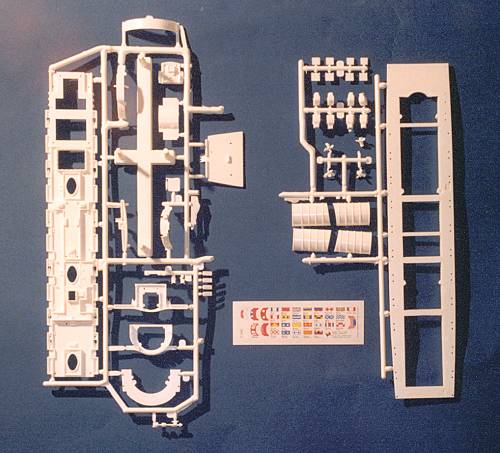
Revell 1:570 Queen Mary

Kit # 05203
Review by Scott Reigel
Revellís 1:570 scale Queen Mary, a model kit dating from the late 1960ís, is a sometimes frustrating mix of old fashioned kit design and historical inaccuracies. That is not to say that the kit is without merit, and there is nothing that keeps the ambitious model builder from correcting the kitís many flaws, but a close inspection of the kit is a story of things going from good to bad to worst.
However, before giving up hope let me say that there are several areas in the kit which are very good, if not excellent, considering the age of the molds. First, the 210 piece kit fits together without unreasonable difficulty and do capture the overall look and feel of the ship fairly well. The proportions and lines of the hull and decks are very pleasing and capture the graceful, sleek look of the original. The lines of the Revell hull are especially appreciated when compared to the Airfix issue of her running mate RMS Queen Elizabeth, the after third of which appears somewhat bloated and overweight.
Also in the plus column, the Revell QM has the advantage of being very nearly 1:600 scale, measuring in at 1:596 and not (thankfully) at 1:570 as advertised on the box. The unusual 1:570 or "Revell Scale" seems to have been strictly for marketing, as Revell has issued perhaps a dozen other ships of various types in this odd ball scale.
Finally, the wide availability of the kit makes it easy to track down either at the local hobby shop or through the usual used model channels. The kit has been reissued throughout the years by Revell, their short-lived subsidiary "Advent", Modelcraft, and currently through Revell of Germany. RoG also produces a deluxe issue which includes a selection of paints. Molding in all issues are identical, with the exception of Advent which is molded in black, rather than white styrene.
This unfortunately concludes the short list of high points of this kit. For the casual model builder the kit makes a fair representation of the ship right out of the box, but for any Queen Mary enthusiast the closer one looks the worse things get.
Generally the kitís shortcomings can be grouped into two categories, either problems in kit design and execution which are largely attributable to the age of the model, and more seriously errors where the kit differs from the actual Queen Mary. Consumerís expectations have changed over the years, the Revellís QM was designed to suit an earlier generation of model builders. As such, the inclusion of exaggerated hull plates and even rivet detail would not be expected on a more modern kit. Likewise the molded in railings (which are actually fairly well executed) and the fact that the deckhouse is horizontally split at mid-height to facilitate window openings should not be found on kits today.
More seriously however there are significant shortcomings in several areas of the model. Most difficult to correct would be the bridge front and forward observation decks which are severely compressed when compared to the original. Fixing this requires major surgery, but even relatively novice scratch builders can correct the bridge windows (six small windows on the kit vs. ten on the original) and add the small cabs missing from the bridge wings.
These two photos dramatically show the errors of the Revell kit when overlaid on the plans of the real vessel.
The deck houses are also an area of major concern being too tall in most areas and very simplified. At a minimum this section would benefit from the addition of a barrel vaulted roof over the main lounge located between the second and third funnels. As depicted in the kit one might think that this area was a sports deck of some type. Other modifications to the deckhouses are limited only by the availability of references and the time required.
The hull offers a couple of curiosities, namely the exaggerated plating and rivet detail mentioned above only extends as far as the waterline with the area below being completely smooth. The propeller shafts are also inaccurate in that Revell, in an apparent attempt to check the number of parts in the kit, depicted them molded into the hull at a bizarre angle. The only solution to fix this would be to remove the foreshortened stubs and replace them with scratch built or pirated pieces. These problems can be ignored if the hull is waterlined, a shame however given the pleasing shape of the hull.

A final hull problem which is similarly difficult to correct is the placement of the Promenade Deck widows. On the actual ship, the supports for the boat davits continue through the deck below and result in the distinct grouping of the windows. On the kit however, the window grouping is completely separate from the davits above, somewhat spoiling the overall continuity of the design. Unfortunately the problem lies in the windows and not the davit spacing so there is no easy fix.
Finally, the covered lifeboats are a bit of an eyesore being without detail on top and tie down ropes a foot thick in scale running around the bottoms. In service the Queen Mary seldom if ever used lifeboat covers after the war (as depicted in the kit). If available these would probably benefit by being replaced with the uncovered boats from the Airfix Queen Elizabeth.
In summary, the old kit shows her age and compares somewhat unfavorably to the Airfix kits of the same era. It can however, given adequate resources, be made into a excellent representation of the original or be built straight from the box as a somewhat flawed but attractive model. As with any modeling project, the choice is up to the model builder to address the shortcomings they feel are significant, while still maintaining the enjoyment of the project.

